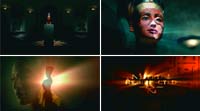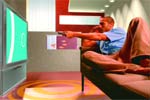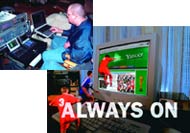We make a lot of money on mistakes that happen on set," says Matt Silverman, director of effects and design for Phoenix Editorial Effects & Design in San Francisco. "It's something that we try to convince our clients to do, and a lot of the time they think they are saving money by not doing it. In reality, if I'm not there on set, things will inevitably go wrong and they end up spending more money on the back end."
Moving along swiftly and not having to fix production mistakes in post are only the most obvious benefits of having that visual effects producer or artist on the production set. These professionals provide the technical expertise to gather the necessary elements and often an artistic eye to help clients visualize the end results. When snap decisions are being made on set, a visual effects producer can often make directors very happy by saving time and, in the long run, money.

Viewpoint, which worked with RhinoFX on three :30 spots promoting the Discovery Channel special Nefertiti Resurrected, went on set to help with the effect of the stone bust crumbling to reveal a live-action woman.
|
"I personally would rather be there," explains Silverman. "If I'm on set, the end product is going to be better than it would be if I wasn't. It's guaranteed that if I'm there, I'm going to spot things that [non-post] people aren't. Also, they might stress out over something that, in reality, is a non-issue. As much as the director might complain that the effects guy is getting in the way, reality is it's taking the heat off them and it's allowing them to relax and get what they need." Alex Catchpoole, a visual effects artist at Guava in New York, explains "One of the things we spend our time doing is seeing on set what isn't there or trying to visualize [it]. On set you've got people from all these different departments - makeup and lighting and camera - they're all looking at what's happening on that day. And we're trying to look two or three weeks into the future and see what's not yet there. We find that directors and DPs are often just ensuring that what they're doing is going to fit with their vision. And if we understand what that vision is, we can add things or take things away from what's happening in front of the camera to make it better."
Not all directors are yet convinced of the necessity of having the visual effects producer on set. And, even if [we are on set], there is an unspoken pecking order. But more on that later, first, let's see how several visual effects companies recently proved their worth during live action shoots.
ANTICIPATING PROBLEMS
"We recently completed a job where there was over $75,000 in overages because of mistakes made on set and not listening to us," says Silverman of Phoenix (www.phoenixeditorial.com ), a studio that specializes in effects for commercials. Signs needed to be composited. Phoenix told them to use tracking marks. The client said it had no money for post so practical props with type were used, which the client later wanted to change. Phoenix had to "very painfully" manually retrack those signs.

Edgeworx provided previs and on-set supervision for this three-part Nova series, called "The Elegant Universe."
|
Phoenix's Silverman has become adept at anticipating problems. For last summer's Yahoo-sponsored spots of FIFA World Cup, that had miniature soccer players scrimmaging on a kitchen floor, Silverman used a Canon 10D camera to take digital stills of the kitchen set background. Originally, the real soccer players had been shot on a giant floor in front of greenscreens,` which were to be replaced with kitchen cabinets. But time ran out on the shooting schedule before there were enough background plates shot. However, Silverman used his stills of those cabinets, graining them to look like 35mm film, and no one was the wiser.
His stills came in handy on a recent spot for a large packaged goods company when some tabletop shots were overexposed. "We had a big-time DP working on the spot, and even a guy like that makes mistakes," he says. "I always bring a digital camera on set, just in case plates on film don't come in."
That :30 spot, currently on air, was posted using Adobe After Effects, Pinnacle Commotion and Alias Maya on a Mac G4. The main tool was Discreet Flint due to heavy tracking and compositing. The tabletop shots were assembled with After Effects.
Silverman shares one more tip: "I try to get the video assists to use Digital 8 for their tape recording format because the Digital 8 have a FireWire output so I can plug the Digital 8 into my Apple PowerBook on set and I can do pre-comps. The Apple PowerBook allows us to capture into Apple Final Cut Pro right from the video assists. We can then do test composites, we can do keying tests, and make sure everything is lining up right before we commit to the shot," Silverman adds.

On-Set Dynamics: Is there a pecking order on set?
|
COMPOSITION ON SET
Edgeworx's visual effects supervisor, John Bair, also uses his tools to compose shots on set. He brings his HP laptop with FireWire running Discreet 3DS Max (though sometimes After Effects and Photoshop). NYC's Edgeworx (www.edgeworx.com) specializes in visual effects for documentaries and films, though it does do commercial work too.
"On [a recent] project it was very helpful to be there and help them compose the shot. Traditionally, you think of it as a very technical type of exercise to be there and make sure things are done right but there's also a lot of artistic input that's happening at that time, a lot of decisions are being made," he says, noting that he also does most of the art directing. "To help these directors really see what's going to be happening, I usually bring animatics and previsualized shots for everything so we can have that on the laptop." This way they can see it and preview it in realtime.

Click 3X was the production and VFX house on a campaign for Brighthouse Cable Network. They previsualized 17 spots in the package, and were on set as well.
|
Bair did this for a major sequence in the three-part Nova series "The Elegant Universe" for client WGBH, airing in late October. In the third episode, a cellist plays in front of five mirrors, a practical effects shot created on a stage because of a complex camera angle with integrated live action. It looks like a digital composite. The camera is behind the cellist and the viewers see her reflection in those mirrors - her whole body was reflected.
"It was an incredibly tricky move [and I did] all the trial and error. When we got to the set it was basically 'put the camera here, put the arm here, position the talent here, do this type of move.' It was pretty amazing to see that this QuickTime movie of the previsualization that I had on set looked exactly like the move we ended up getting. It adds a lot of comfort to the director's mind," he says.
Bair used Discreet 3D Studio Max 5.1 for 3D and After Effects 5.5 for compositing. Finishing work was done on an Avid|DS.
PREVISUALIZATION
Click 3X (www.click3x.com) in NYC, whose visual effects are seen in many spots and broadcast packages, is meticulous about its use of previsualization and on a large project for Florida's Brighthouse Cable Network was super organized. In this case, Click was also responsible for production. The client was the Fry, Hammond, Barr agency in Orlando.

Steve Chiarello, VP/senior producer at NYC's Charlex (www.charlex.com), says the studio often sends VFX supervisors into the field to coordinate shoots involving 3D. They will take measurements of the set and construct a lighting diagram marking the position of lenses and lights. They'll also take digital photos for reference.
|
The Brighthouse visual effects project used heavy motion control and many virtual sets. "Since there was a tremendous body of work that we had to do, we previsualized every single one of the 17 spots, and we built the whole environments in 3D first. Then we animated them and I got the creatives involved to really design the camera moves they would like to see," explains Click visual effects supervisor Peter Corbett. "It was full 3D, full camera information [though the people were represented by blobs only]. Then we were able to take that information and translate that into motion control moves that we preprogrammed so when everyone actually came, and the money started rolling on the set, we actually had all the moves worked out. The clients walked on and it was all done by numbers at that point.
"We were even posting the motion control data in CG on the fly, on set, right from the camera so we could make sure we had the moves correctly tracked."
He adds, "It's a matter of how we accomplish all of this without slowing down the whole process, so we have to be very button upped and sure of ourselves technically, and that's where visual effects supervision becomes a real money saver both in the post and even on the shooting side."
TIME AND MONEY
How about saving time? Guava's (www.guavanyc.com) Amber Wilson, a visual effects/Flame artist, says "We actually saved a whole half day of shooting" on a :30 American Express spot for Ogilvy & Mather. In it, a credit card receipt flutters throughout the scene. "We were quite lucky with the day of shooting because the lighting was perfect, it was very evenly lit, a very fluorescent type of day. Rather than using the following day of our live-action shoot, when we were supposed to go into a studio and set up a huge greenscreen and do all these passes with the receipt but the lighting was so perfect on the day of the shoot we just decided to throw up a green cyc right then and there and shoot what we needed. We were outside, shooting in an alleyway and it was perfect."
And, she adds, "Us being there can make the whole process go a lot faster in post." Discreet Flame and Smoke were used for the online editing. The visual effects studio is located in Manhattan.
This NYC-based studio is also is a firm believer in previsualization. "If we have time we try to do some previsualization here before we go," says Wilson. "We do our own mockups and testing to see if there's anything we might not have come across with our discussions with the production company. One other thing we do here is shoot in our facility just to mock up things so we can then throw it into the Flame and check it out," says Wilson.
THE X-FACTOR
Viewpoint Studios creative director Joseph Kiley goes on set to search for the X-factor. "In every shoot situation, there's always the X-factor and having someone there who understands what he or she needs in post when we're doing the final composite, it allows us a little bit of flexibility when we're doing the shoot if something goes awry or there needs to be a change in creative or the client is making unreasonable requests or various situations. You can immediately turn around and talk to your visual effects supervisor, come up with an effective solution that's not going to kill your budget when you reach post."
Viewpoint Studios (www.viewpointstudios.com) in Needham, MA, creates visual effects for network packages, promotions and spots. David Shilale is the executive producer and Dave Dinisco the Flame artist.

Phoenix's Matt Silverman (inset) went on-location to help with effects for this Yahoo spot.
|
For an August Discovery Channel special on the Egyptian Queen Nefertiti, Viewpoint concepted the promo campaign, which included three :30 spots, working closely with RhinoFX. The major effect was a stone bust of the queen that rumbles and breaks apart, revealing a real woman. Three different practicals were used - the bust queen, bust cracked and a mask with pieces that fell off. Most of the effects work was done at Rhino-FX because that shop was in charge of posting the promos that aired theatrically in HD. They used Discreet Inferno, with some work done in Maya.